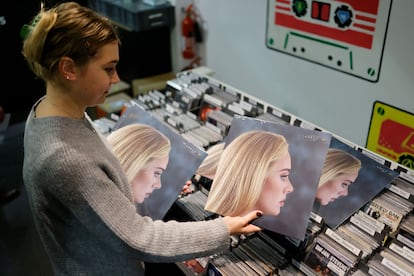How Adele’s ‘30′ upended the vinyl industry and caused prices to spike
In 2021, the Londoner’s latest release soaked up all the raw materials and made record albums more expensive

Vinyl record sales have been growing for over a decade and labels were quick to jump on the bandwagon. In the era of streaming music from the likes of Apple Music and Spotify, vinyl record sales peaked in 2021, soaking up global production capacity. The impacts are still being felt two years later, and it was all because of one of the world’s biggest stars – Adele.
In 2020, Sony Music ordered the production of 500,000 vinyl records of 30, Adele’s new release. The vinyl record pressing factories were swamped and had to stop producing other albums scheduled for release in the coming months. This happened not only because of the quantity ordered by Sony but also because the label pushed for a simultaneous vinyl and digital release on November 19, 2021. All of Adele’s previous albums were released on vinyl about a year after the digital release, according to Mark Kitcatt, director of Popstock! España, the Spanish distributor for Adele’s albums.
With the factories at maximum capacity, other recording artists had to wait up to nine months for a vinyl album release, according to Variety. Newcomers and unknowns were not the only ones affected. Current and former stars like Elton John, Coldplay and ABBA were put on hold, prompting complaints from distributors and artists. Ed Sheeran told an Australian radio station that the backup caused by Adele’s 30 forced him to speed up work on his Equals album by two months to ensure a timely release of the vinyl version. Despite the industry chaos it caused, 30 sold 318,000 copies according to Forbes, making it the most successful vinyl release of 2021 by far. Still, hundreds of thousands of unsold copies gathered dust on store shelves because of exorbitant prices – $40 (€37) – when it was first released.
Production delays, supply shortages and high prices linger today, says Eugenio López, partner and co-founder of Mad Vinyl Music, a Spanish vinyl album pressing factory. According to López, everyone uses the same suppliers of raw materials, which is why larger factories like G2 Media and Record Industry soaked up almost all the resources. “We bought plastic ahead of time, but we couldn’t buy the covers,” said López.
Raw material scarcity meant that the consumers paid higher prices. “We had delays of three to four months because we not only had supply problems, we were in the middle of a pandemic,” said López. He says the supply has now stabilized, but prices remain high. “Plastic is still expensive because of the price of the oil used in manufacturing. And cardboard costs almost 40% more now.”
With no sign that prices will come down soon, record stores have adapted to the new prices, a reality shared by manufacturers, distributors and vinyl enthusiasts. Being a purist music lover has become more expensive.
Sign up for our weekly newsletter to get more English-language news coverage from EL PAÍS USA Edition
Tu suscripción se está usando en otro dispositivo
¿Quieres añadir otro usuario a tu suscripción?
Si continúas leyendo en este dispositivo, no se podrá leer en el otro.
FlechaTu suscripción se está usando en otro dispositivo y solo puedes acceder a EL PAÍS desde un dispositivo a la vez.
Si quieres compartir tu cuenta, cambia tu suscripción a la modalidad Premium, así podrás añadir otro usuario. Cada uno accederá con su propia cuenta de email, lo que os permitirá personalizar vuestra experiencia en EL PAÍS.
¿Tienes una suscripción de empresa? Accede aquí para contratar más cuentas.
En el caso de no saber quién está usando tu cuenta, te recomendamos cambiar tu contraseña aquí.
Si decides continuar compartiendo tu cuenta, este mensaje se mostrará en tu dispositivo y en el de la otra persona que está usando tu cuenta de forma indefinida, afectando a tu experiencia de lectura. Puedes consultar aquí los términos y condiciones de la suscripción digital.
More information
Archived In
Últimas noticias
Trump claims peace in Ukraine is near, but Moscow suggests otherwise
A survivor’s account of the Interoceanic Train accident: ‘We were scared because of the speed on the curve’
The Interoceanic Train, the Mexican alternative to the Panama Canal
What is known about the Interoceanic Train derailment in Oaxaca
Most viewed
- Oona Chaplin: ‘I told James Cameron that I was living in a treehouse and starting a permaculture project with a friend’
- Reinhard Genzel, Nobel laureate in physics: ‘One-minute videos will never give you the truth’
- Why the price of coffee has skyrocketed: from Brazilian plantations to specialty coffee houses
- Pablo Escobar’s hippos: A serious environmental problem, 40 years on
- Chevy Chase, the beloved comedian who was a monster off camera: ‘Not everyone hated him, just the people who’ve worked with him’











































